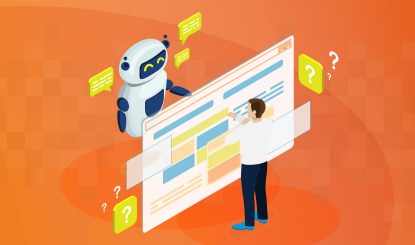AI has proliferated the public conversation and it’s likely to continue to play a role in the way businesses think about their operations. However, anyone who’s looking to implement AI at their organization may have a tough time navigating the many different options that exist within the industry.
The focus on generative AI and the Large Language Models (LLM) that power them have been the primary focus, but there’s also a slew of other options that aren’t even talked about. AI models have been a part of most business operations to some degree for some time, and there’s a good case to be made for their implementation in almost every business, but it’s critical that business leaders find ways of separating the hype from the value that AI systems can deliver.
So, how can you as a business leader get started?
Where to Start with AI Implementation
Fundamentally, every journey begins with defining what you’re looking to get out of an initiative, and that’s no different when it comes to AI. Tools that use AI are designed to fulfill a specific need, and that means that your investment in such tools must have a specific purpose in mind. Wanting to take advantage of the buzz isn’t a bad thing, but it’s unlikely to maximize ROI if that is your only driver.
The most common uses of AI in organizations are to automate processes that are often seen as repetitive and take away time from value adding activities. One prime example of how AI is used in process automation is invoice processing, because it often requires data entry that’s time consuming and diverts valuable resources away from growing the business just to keep the lights on. You can find out more about how AI can be used in process automation here.
However, tools like OpenAI’s ChatGPT have made it possible for organizations to take automation to a whole new level. While it’s not quite at the point of replacing traditional specialists, advances in LLMs have made it possible to implement tools like Microsoft’s Copilot and will eventually be available for use in Microsoft’s existing offerings, from Outlook to Power Virtual Agents. These tools have reduced the barrier to entry for business professionals to access knowledge about their organization and specific operations without needing a highly technical background to get the job done, assuming the solution you’re looking to build is relatively simple.
Once you define the goal of your implementation, you’re ready to invest right? Well, not exactly.
AI Solutions: Buying, Building, and Embedded
Having a goal in mind might be step one, but once you have the specific goal in mind, the conversation changes to how you can close the gap between where you are and where you want to be as an organization. The best way of thinking about this gap is to consider it in terms of whether you want to buy, build, or embed an AI solution within your organization.
We’ve already touched on deciding when you should invest in custom versus off-the-shelf software elsewhere on our blog (which you can read here), but with AI, there’s a little more to consider.
Buying a Solution
There is no shortage of “AI Powered” tools to purchase for your organization, and the value each delivers differs depending on the goal. Whether or not you should buy your AI solution largely depends on how complex a problem you want to solve and how widespread it is within your industry. For example, banks frequently look for tools that can help them with fraud detection, and the market for such tools is large enough that third party vendors have developed AI powered, fraud detection software that banks can buy.
The other area where you’re likely better off buying a solution over building one yourself is if the task you’re looking to solve for is a relatively simple one that is broadly experienced by the market. Tools that can help with processing invoices, making recommendations, or that create a conversational interface are examples of tools that can be used in this way.
Building a Solution
Massive, broad-application AI models like those used by OpenAI, Palantir, and Google’s Bard are the darlings of the tech industry, but these models require a massive amount of computing power and resources to create, making them beyond the reach of most businesses. However, that doesn’t mean that organizations aren’t able to create their own AI tool.
As with any software development project, there are some considerations when thinking about whether to buy a solution or build it yourself. AI is a little different than most, though, because it doesn’t require building from scratch.
Microsoft actually put together a suite of products in Azure Cognitive Services that allow organizations to use AI to improve processes within their businesses. A prime example of this is using Azure Cognitive Services to create a document cognition model (which we talk about in greater detail here) that can be used to help process invoices, handle form processing, analyze and tag images, and more.
Tools like Microsoft’s allow organizations to deploy smaller scale AI solutions that can be used to create a more scalable business, and it has the benefit of being perfectly tailored to your business’s individual needs. Additionally, using a customized approach with proprietary data means that the AI solution can be adapted to meet the needs of evolving operations rather than remaining static to the time when you initially invested in the solution.
An Embedded Solution
With AI entering the business world’s zeitgeist, there’s almost always going to be an AI feature rolled out for most solutions, which leads to the possibility of using the embedded AI solution to transform your business.
For example, if you’re looking for an ERP solution, then you might already be evaluating major players like Oracle, SAP, or Workday, which have rolled out AI tools to streamline the resource management process. Or, if you’re trying to solve for a better ticketing system and considering ServiceNow, then you’ll be able to utilize the AI tools available within the ServiceNow platform to automate workflows and boost the user experience internally and externally.
A Time Horizon For AI
While there are a lot of solutions available today in the world of AI, there’s also a lot of misunderstanding about what it can achieve in the organization itself. In many cases, organizations need to have a data environment that’s clean and normalized in a way that’s conducive to training an AI model, especially if data insights are what you are after. This crucial first step could require investing in tools that would improve your overall data environment before even considering the implementation of an AI solution.
However, it may be that automating a handful of tasks in the short term would be preferable and have larger impact on your business than planning for a broader implementation five years down the line. It’s certainly possible to handle short, medium, and long term planning as well as parallel efforts, but it’s necessary to set that time horizon early so it’s easier to prioritize which solutions to implement first.
Developing a timeline for most AI deployments largely depends on what specifically you’re looking to accomplish within your organization. If you’re looking for help with identifying solutions, contact us and one of our digital transformation consultants can help with defining the best course forward.



